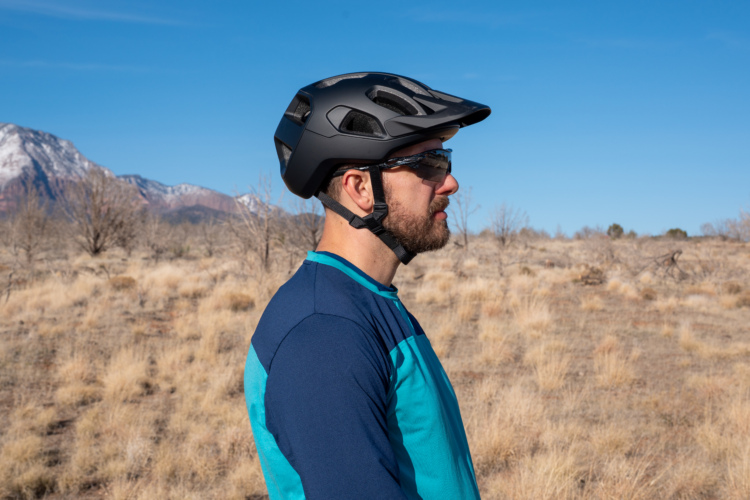
The Specialized Recon 3.0 is marketed as a “gravel and XC shoe,” sitting somewhere in the mid-to high-end. Retailing for $250 USD, they’re not cheap, though they are priced $200 less than the S-Works Recons. Specialized claims the Recon 3.0 weighs 345g per shoe in a size 43, and my 45s weigh 407g including cleats which isn’t too far off. The Recon 3.0 has been completely updated since Matt reviewed the shoe in 2020, ditching the hook and loop strap near the toe and updating the tread pattern.
Specialized Recon 3.0 shoe specs
- Dual BOA closure
- Weight: 407g per shoe as tested, including cleats
- Price: $250
- Buy from Specialized
The Recon 3.0 features the same stiff, carbon sole plate as the S-Works version. Using Specialized’s Body Geometry tech, they claim it’s “backed by science to boost power, increase efficiency, and reduce the chance of injury by optimizing hip, knee, and foot alignment.” Their “STRIDE carbon toe flex technology” provides stiffness on the pedals, while allowing for flex around the toe box and upper areas, making them easier to walk in.
Compatible with all two-bolt MTB cleat interfaces, the Specialized Recon 3.0 shoes come in sizes 36-49, with half sizes from 38.5-46.5. There are two colors: Black, and Dusty Clay. The latter, on test here, is sort of a light pink. The upper is fully welded with no seams, and is made from a synthetic water-shedding ‘XPEL’ material with small perforations in it. The shoe fastens with two BOA Li2 dials per shoe, and has sticky SlipNot rubber on the sole, with an aggressive tread pattern. Despite what the Specialized website says, the Recon 3.0 does not feature removable toe studs. A plastic bumper at the front of the shoe provides some toe protection.



How does the Specialized Recon 3.0 fit?
I’ll preface this by saying that it’s rare for me to get a perfect fit on a shoe, if not impossible. As a solid size 45, the size 45 Recon 3.0 worked pretty well for me. The toe box feels particularly wide, though I feel like it could be narrower; it isn’t uncomfortable, but there is a little movement in there. I also tried a size 44.5, but that felt a little tight, so 45 it is. The BOA ratcheting lace system allows you to dial the tension in with precision, and the dual-dial feature allows you to back the tension off a click at a time while riding, which is handy. The upshot is a snug feeling overall. While riding I noticed a little fore-aft movement in the shoe, particularly in the heel, though this could potentially be fine-tuned out with insoles.
On the trail
On trail, the Specialized Recon 3.0 performs up as the stiff, lightweight shoe it promises to be. Despite the roomy toe box, the cleat area feels plenty stiff, and the BOAs mean you can cinch the shoe up nice and tight. Putting power down there is very little flex, making for an efficient feel, transmitting power to the pedals nicely.
Clipping in is easy enough, with the aggressive tread guiding the shoe into the pedal well, but not quite as nicely as a more enduro-focused shoe. Speaking of tread, the chunky, sticky knobs on the Recon 3.0 make hike-a-biking on loose ground damn easy, and the knobs dig in better than almost any other shoe I’ve tried. The sole is less grippy on rock, where a flat, flexible sole is preferable, but I prefer to spend my time riding the bike, rather than pushing it anyway.

There are downsides to having such a stiff shoe however; any issues with fit or setup, such as cleat position, become apparent much faster. I find that I really have to get my cleat position dialed for my knees to be comfortable with the Recon 3.0, whereas a shoe with more flex can be much more forgiving, especially over longer rides. I found that tuning the shoe with footbeds also made a difference here, and once I got this figured out, they were quite comfortable over long, 4-hour+ race days at BC Bike Race. I also find that the stiffer sole on the Recon 3.0 makes it a little easier to accidentally unclip while riding; this happened to me a few times on technical descents, and while it didn’t cause any problems, it’s something I have to think about.
Despite having what looks like very few ventilation holes, the shoes actually vent quite well, with a little breeze at moderate pace, though they’re not super airy. I never found my feet getting hot while pushing hard during this summer’s 30ºC+ days, and the ‘XPEL’ material does a decent enough job keeping splashes at bay.


Pros and cons of the Specialized Recon 3.0 shoes
Pros
- Light weight
- Stiff and efficient
- Good bang for the buck
Cons
- Stiffness make setup problems more apparent
- Toe box is a little on the roomy side for me
Bottom line
Overall, the Specialized Recon 3.0 is an excellent mid/high-end XC/trail/gravel shoe. Pushing outside of the XC focus with its knobby soles and toe bumper, it’s a little more trail-oriented than some of its racier siblings, and is a shoe I’m happy to wear all day on a variety of trails, though it is a little scant on the protection front.
No, the Recon 3.0 is not cheap, but for what you get, it’s a good value for the money, costing approximately half of the S-Works and equivalent S-Phyre Shimano shoe and delivering a lot more than half the performance. Looking for an affordable XC race shoe? The Recon 3.0 would work damn well. Looking for a high end XC-light trail or gravel shoe? It fits that bill too. Just take your time to get your sizing and setup right.




















0 Comments